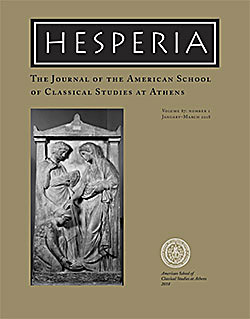Hesperia 87.1 Now Online!

The American School of Classical Studies at Athens is pleased to announce the publication of Hesperia 87.1. Topics in this issue include a look at the North American reception of Michael Ventris's decipherment of Linear B; an examination of the terms used by scholars when discussing the Early Iron Age of Greece; a study of patron-client relationships in democratic Athens; an iconographic review of the identifying attributes of deceased maidens on Classical Attic grave reliefs; and the results of an investigation into the soundscapes of two Byzantine churches located in Thessaloniki.
Subscribers can read the issue online at JSTOR, which now hosts all current issues of Hesperia as well as an archive of past volumes. The printed version will be mailed shortly.
The Acceptance of the Greek Solution for Linear B, by Stephen V. Tracy, traces the timeline of events that followed Michael Ventris's 1952 public announcement via BBC Radio that Linear B is a form of early Greek. Using the personal letters of Ventris, Sterling Dow, Carl Blegen, and Emmett Bennett, the author presents a narrative of the reception to this news in North America and details the role of Blegen and his timely publication of the Pylos tablets to the decipherment and acceptance of Linear B.
Lights and Darks: Data, Labeling, and Language in the History of Scholarship on Early Greece, by Sarah C. Murray, shows how the terms used in 20th-century academic publications can trace the development of scholarly thought. Here the subject is the period of 1200 to 700 B.C., for which the terms "Dark Age" and "Early Iron Age" have been used. An analysis shows that the shift away from the use of the term "Dark Age" to the more neutral "Early Iron Age" was largely precipitated by an increase in archaeological discoveries that proved this time period was not as devoid of culture or technology as originally thought.
The Economy of Gratitude in Democratic Athens, by Ingvar B. Maehle, looks at patron-client relationships in 5th-century Athens. In a time of democratic ideology, patronage in Athens served as a way for the elites to solidify and project their reputations as honorable men through their social network. This social capital would prove especially beneficial if or when a patron became engaged in a judicial battle in one of Athens's many courts.
Lament and Death instead of Marriage: The Iconography of Deceased Maidens on Attic Grave Reliefs of the Classical Period, by Katia Margariti, examines the iconography of deceased maidens on Athenian grave reliefs and challenges the long-held belief that the presence of a loutrophoros indicates the commemorated female died before marriage. The author concludes that depictions of the maidens are more nuanced, and she offers a suite of iconographic criteria that can lead to their identification.
Soundscapes of Byzantium: The Acheiropoietos Basilica and the Cathedral of Hagia Sophia in Thessaloniki, by Sharon E. J. Gerstel, Chris Kyriakakis, Konstantinos T. Raptis, Spyridon Antonopoulos, and James Donahue, presents the results of a research project that examined how sound was produced and received in two Byzantine churches in Thessaloniki. By looking at a variety of factors, including architectural design and liturgical performance, a fuller picture of Byzantine soundscapes emerges. Eight audio recordings accompany the article and bring to life this multidisciplinary archaeoacoustical study.
Click here to subscribe to Hesperia. In addition to receiving printed issues and online access to Hesperia, subscribers also receive complimentary online access to Hesperia Supplements, and Agora and Corinth volumes.
Hesperia welcomes submissions from scholars working on all aspects of Greek material culture, including archaeology, art, architecture, history, epigraphy, and related studies. Further information about the journal, including instructions for preparing manuscripts for submission, can be found on our website.